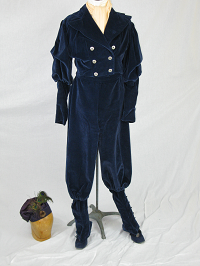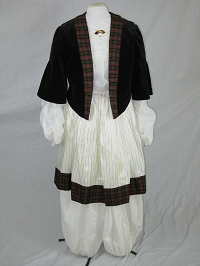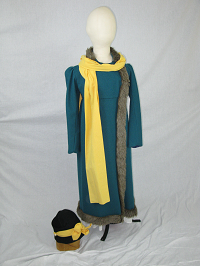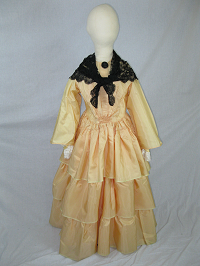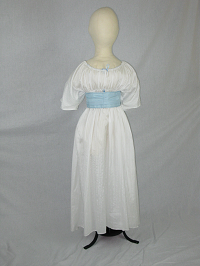
- Details
- Category: 19th century
- Hits: 2587
1894
The 1890s brought a dramatic change in style. The skirts were deflated and sleeves ballooned. By this time Harper’s Bazaar was featuring a whole page of sports costumes. This page contained not only tennis gowns and riding habits, but also new costumes for the gymnasium, hunting, and bicycling. Cycling was an extremely fashionable sport in Paris and this attire is an 1894 French creation. Much was said and written concerning the proper dress for women who “rode the wheel.” The blue velvet bloomers are long and ample, almost giving the illusion of a skirt. Beginning with Amelia Bloomer in the 1850s, attempts had been made to introduce trousers, and by the middle of the 1890s they were becoming acceptable, especially for active wear. Trousers were first accepted for bathing at the beach, but bicycling finally made trousers acceptable for public wear, putting an end to the Victorian sense of modesty. The fitted jacket is short double-breasted with silver buttons and wide lapels. The neckline is accented with a peach ascot. The two-piece leg-o-mutton sleeves are very full and gathered at the top and tightly fitted from elbow to wrist. The hat is a blue silk tam-o-shanter with peacock plumes. Blue velvet gaiters covered the legs.
Click photo for detailed view.
- Details
- Category: 19th century
- Hits: 2669
1850s
In the 1850s, Amelia Bloomer made a great attempt to persuade women to adopt a more rational costume in the form of frilled trousers which became known as “bloomers.” Only the more daring tried the new outfits, like this black velvet jacket over a white sheer bodice, knee length skirts and white flowing trousers. Magazines advised young ladies to have nothing to do with this unladylike garment and to stick to the crinoline in spite of its inconvenience. They were also told not to attempt to climb stiles (steps that allow people to climb over a fence or wall but not animals) and to remain indoors in a high wind. Hats such as this were worn at seaside and country, but were never worn on Sunday and never, never to church. Some had ribbons attached in the front to hold it on in the high wind. Thin shoes, except for dancing, have vanished by this time, and boots ending just above the ankle laced on the inside or buttoned along the outside.
Click photo for detailed view.
- Details
- Category: 19th century
- Hits: 2836
1810
As gowns became thinner, coats were needed, especially in the cooler climates of England and North America. This fur trimmed wool coat was worn for winter. The waist line of this coat follows the empire style and fits just under the bustline. A long shawl and a helmet-type felt hat trimmed with yellow ribbon were copied from an 1808 French fashion plate.
Click photo for detailed view
- Details
- Category: 19th century
- Hits: 2540
1850s
This dress has the back fastenings of the 1840s combined with features from the 1850s, such as the widened sleeve over lace half sleeves and the deeply flounced skirt. The flounces, on already full skirts, increase their width. A lace pelerine contrasts with the peach of the gown. Gloves were a must and these match the lace pelerine. The fan helped to move the air and could be used to communicate across the room with one’s beau, if he knew the language.
Dress makers of the 19th century were women and many traveled from home to home each year to remodel last year’s gowns and to make new ones. One new dress a year was considered sufficient for the ladies of the fast growing middle class. This crisp rustling dress has a draped front ending in the front with gathers at the long pointed waist. The detachable sleeves could be laundered as well as the layers of petticoats and underclothes. Ready-made garments which required no fitting were available in shops but as long as the body of the fashionable dress fitted tightly, production of ready-made dresses was limited. The changing hair styles show its effect on the shape of the bonnet and cap. The white cotton cap is edged with closely gathered muslin frills and trimmed with lace.
Click photo for detailed view.
- Details
- Category: 19th century
- Hits: 2791
1804
Cotton, long denied the middle class, became less expensive and more available by the early 19th century. This sheer white muslin day dress shows evidence of the Greek and Roman influence. The classical silhouette with its high waist and column-like skirt was triggered by the finds of Pompeii. The bodice and half sleeves are lined. Heavily gathered in the back, the skirt ends in a short train. This style of gown had been popular for children since 1780, but with a wide colored sash and no train, so girls of that generation grew up experiencing little change in fashion. Up until this time, children were dressed as little adults, but by the 19th century, new fashion styles were sometimes put on children first before the style was worn by adults.
Grecian style necklace and bracelets complement the classic look. The short and curly hair style became fashionable when the hair of the nobles was cut during the French Revolution before they were taken to the guillotine. The classical toga was doomed to limited success; its bare throats and legs might have been fashionable, but the transparent muslin offered no protection from cold drafts in the cooler northern climates. Buttons were still considered masculine, so this bodice front is held in place with straight pins. Stays were discarded, but support was achieved by an extra vest fastened with straight pins beneath the bust. By 1800 undergarments consisted of a knee-length chemise with short sleeves. Elastic drawers, of knitted cloth, appeared in 1806, and were considered a status symbol, worn only by the very rich and considered immodest by matrons. It was said that the sheerness of these dresses made the legs blush, so pink stockings were often worn. Sandals were the style; some laced up the legs with ribbons.
The English and Americans accepted the near nudity of French fashions with moderation. Some stays or corsets were discarded by the fashionable, but returned early in the new century. The chemise was no longer called a shift and has shortened to knee length. Many had a bodice of coarser material tied or pinned across the front which substituted for the corset.
A long shawl is meant to keep off the draft. The draping of the figure with a long shawl became popular when Napoleon’s soldiers brought back cashmere shawls from their campaigns across the Mediterranean world and central Asia. These many colored woolen shawls helped chase the chill but were expensive, costing as much as $10,000. Josephine was said to have over 100. Napoleon did not like them and kept throwing them in the fire. English paisley printed copies were introduced and the lace kerchief of the earlier period evolved into long narrow shawls. Long gloves were worn with short sleeves.
Click photo for detailed view.
Page 7 of 13
